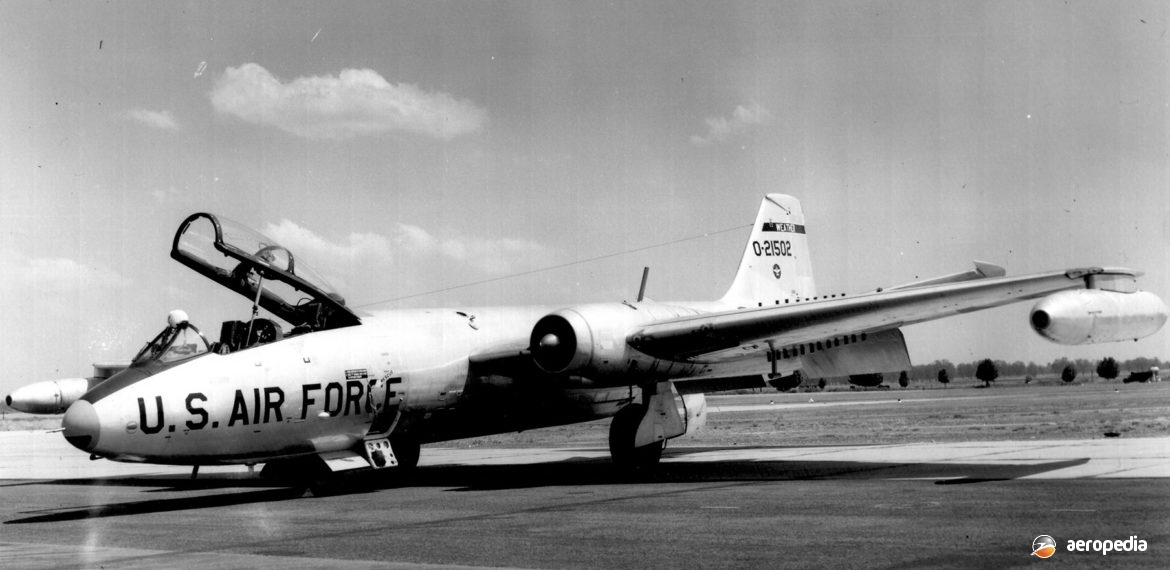Photograph:
Martin B-57 52-1502 at RAAF Laverton, VIC in 1961 (RAAF Museum)
Country of origin:
United States of America
Description:
Reconnaissance bomber
Power Plant:
Two 7,200 lb st Wright J-65-W1 turbojets
Specifications:
- Wingspan: 19.51 m (64 ft)
- Length: 19.96 m (65 ft 6 in)
- Height: 4.75 m (15 ft 7 in)
- Wing area: 89.19 m² (960 sq ft)
- Max speed without wingtip tanks at sea level: 925 km/h (575 mph)
- Max speed at 6,096 m (20,000 ft): Mach 0.85
- Service ceiling: 16,154 m (53,000 ft)
- Max range with ferry tank, with reserves: 3,701 km (2,300 miles)
- Empty weight: 12,247 kg (27,000 lb)
- Loaded weight: 24,948 kg (55,000 lb)
Armament:
Eight fixed 12.7 mm (0.5 in) forward firing machine guns in nose; provision for 16 underwing rockets; up to 2,722 kg (6,000 lb) of bombs in rotary bomb-bay.
History:
Following the outbreak of the Korean War in 1950, the USAF found it was in need of a medium bomber and, as designs of bombers by Martin and North American were a long way from introduction to service, the decision was made to build the English Electric Canberra under licence, Glenn L Martin & Co of Baltimore, Maryland, being awarded an order for 250 aircraft. The design was re-engineered to meet US requirements and this took some time, the first American aircraft, a B-57A (52-1418) flying on 20 July 1953, being followed by a pre-production batch (52-1419 to 52-1425), deliveries to units beginning in 1955. Power plant was the Wright J-65 turbojet, a licence-built variant of the Armstrong Siddeley Sapphire. The first Canberra to carry a USAF serial was an English Electric Canberra B Mk 2 (WD932) which became 51-17352 and it was flown at Baltimore on 21 February 1951.
The type was produced in a number of variants, the B-57A, B-57B and B-57C bombers, the RB and EB-57D and RB and WB-57F high altitude models, the latter being used to good advantage for weather and special reconnaissance missions, some being converted for electronic-countermeasures missions. The RB-57A was similar to the B-57A but had cameras in a bay to the rear of the bomb-bay. Sixty-seven were delivered and equipped the 363rd Tactical Reconnaissance Wing. The B-57C was a transition trainer with dual controls and 38 were delivered. The B-57E was a B-57B equipped with target-towing equipment, target containers being fitted to the lower rear fuselage.
Some 68 B-57Es were completed and served with Tow Target Squadrons, the first unit being equipped in 1961. The RB-57E was a major re-design, retaining the B-57B fuselage but having an extended wing for high-altitude operations and being powered by two J57-P-5 engines, wingspan being 32.3 m (106 ft) or 32.76 m (107 ft 6 in) when radomes were fitted to the wingtips for electronic reconnaissance. In 1962 General Dynamics re-engineered the design and converted 21 to WB-57F configuration, these having a 37.19 m (122 ft) wingspan.
The B-57 served extensively in Vietnam, being the first bomber to drop bombs on Viet Cong forces on 19 February 1965, and continuing in service there until 1972. Some 95 examples served in Vietnam and of these 63 were lost due to enemy action and other causes. Many B-57s were upgraded to B-57G configuration and many of these served from Ubon in Thailand using sensing and target tracking systems. In 1959 the US Government supplied B-57Bs to the Pakistan Air Force and these saw combat in the 1965 and 1971 wars with India.
As part of a series of operations known as Crowflight, which involved the use of Lockheed U-2s from Victorian bases, a number of B-57s attached to the USAF 57th Weather Reconnaissance Squadron, operated from Avalon, VIC, whilst the U-2s operated from East Sale and Laverton. Details of these operations are set out in the Lockheed U-2 article, but basically four B-57s (52-1496, 52-1500, 52-1503 and 52-1506) of the 4926 Test Squadron, ARDC, arrived in October 1960 and stayed about a month.
A second flight of four B-57s (52-1496, 52-1498, 52-1500 and 52-1502) arrived in April 1961 and also stayed about a month. A further group involved four B-57s (52-1496, 52-1498, 52-1503 and 52-1504) of the 57th Weather Reconnaissance Squadron during November 1961. It is known these were JB-57B-MAs. A further three arrived in March 1962 (including 52-1496).
However, the B-57 did not have a totally happy period in Australia. One (52-1496) on 17 September 1962 performed a slow roll on take-off, crashed and was totally destroyed by fire. A second crashed on 16 October 1962 about 3.2 km (2 miles) off-shore near Lorne, VIC and was also totally destroyed. And a third (50-33827), a B-57C, crash landed at Avalon on a foam covered runway after undercarriage problems.
On 17 January 1965 an RB-57F arrived at Laverton from Guam where the crew spent a week surveying RAAF bases in southern Australia before departing to its home base in Albuquerque, New Mexico. In August 1965 two RB-57F-CFs (63-13292A and 63-13294A) from the 57th Weather Reconnaissance Squadron with supporting aircraft arrived and operated from East Sale until February 1966, being placed on display at an Air Force Week event at East Sale on 12 September 1965. In 2007 the forward fuselage section of a B-57 was imported and placed on display at a museum at Arnold near Bendigo, VIC.

